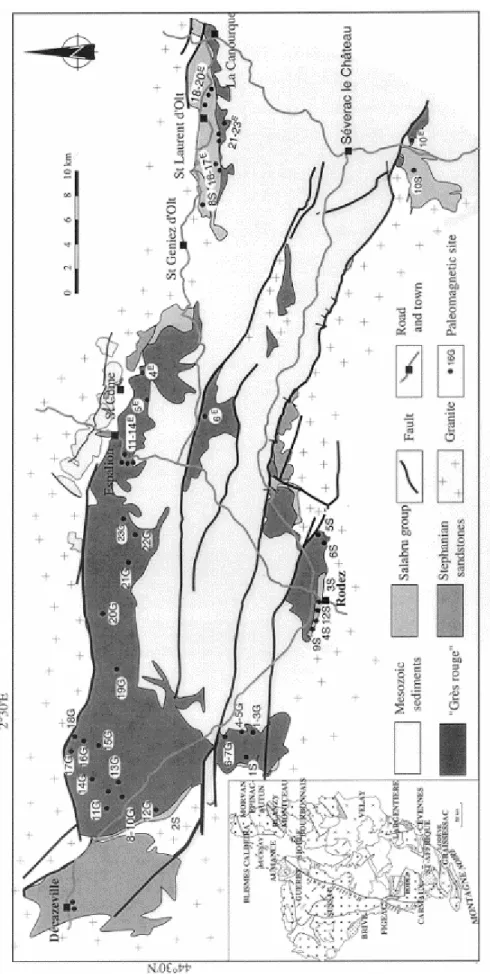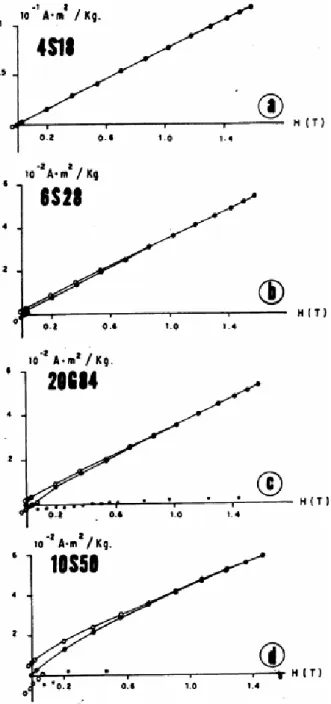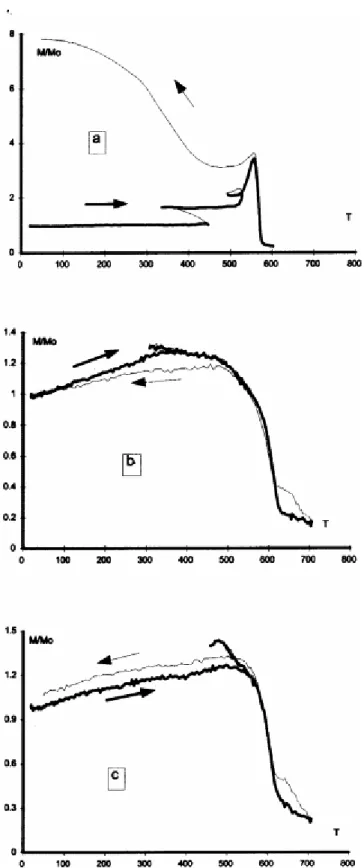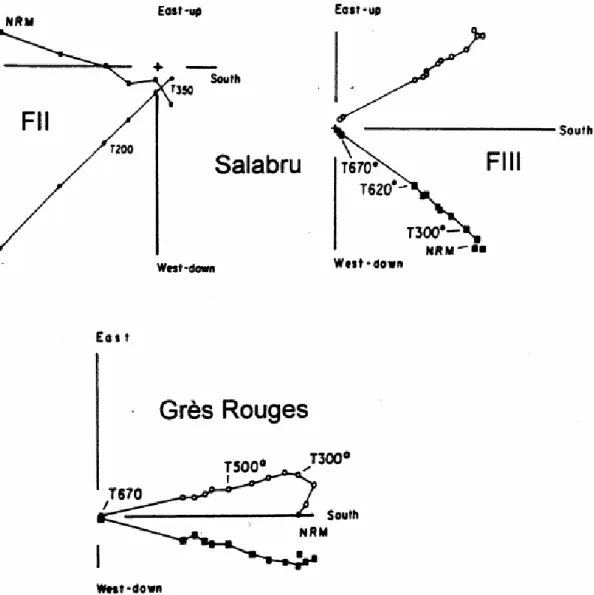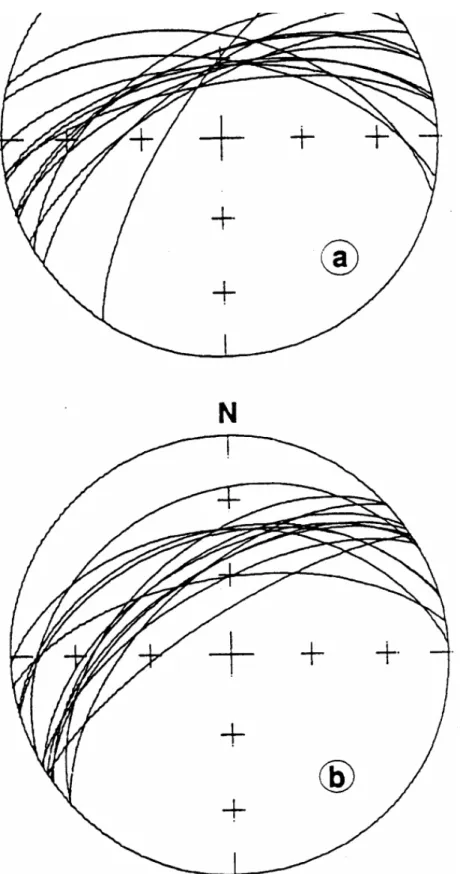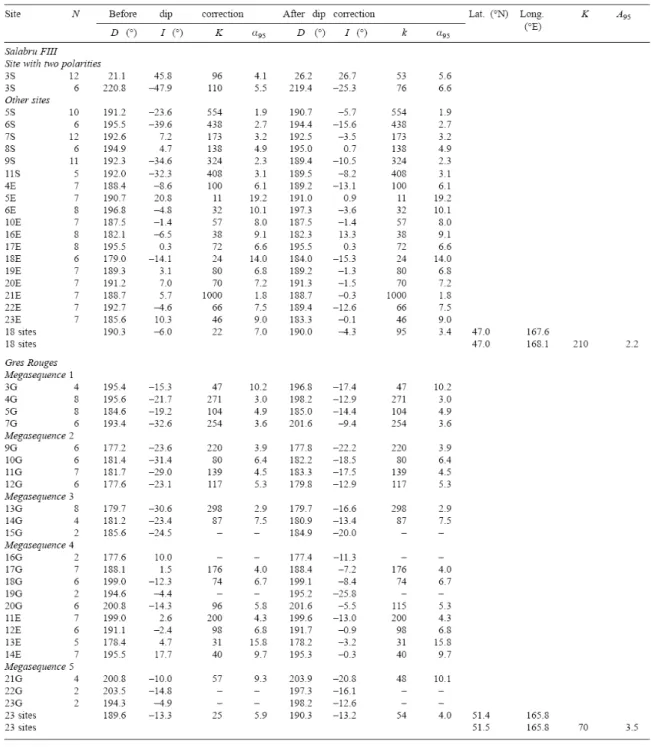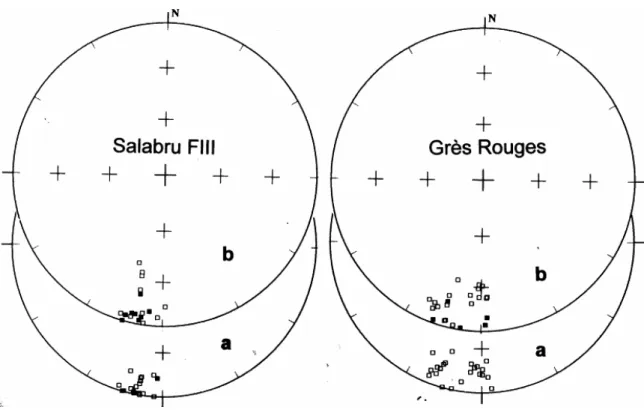HAL Id: hal-00076894
https://hal-insu.archives-ouvertes.fr/hal-00076894
Submitted on 17 Jan 2007
HAL is a multi-disciplinary open access archive for the deposit and dissemination of sci-entific research documents, whether they are pub-lished or not. The documents may come from teaching and research institutions in France or abroad, or from public or private research centers.
L’archive ouverte pluridisciplinaire HAL, est destinée au dépôt et à la diffusion de documents scientifiques de niveau recherche, publiés ou non, émanant des établissements d’enseignement et de recherche français ou étrangers, des laboratoires publics ou privés.
Implications of paleomagnetic results from the Permian
Rodez basin for the late Variscan tectonics in the
southern French massif Central.
Arturo Diego-Orozco, Yan Chen, Bernard Henry, Jean-François
Becq-Giraudon
To cite this version:
Arturo Diego-Orozco, Yan Chen, Bernard Henry, Jean-François Becq-Giraudon. Implications of pa-leomagnetic results from the Permian Rodez basin for the late Variscan tectonics in the southern French massif Central.. Geodinamica Acta, Taylor & Francis, 2002, 15, pp.249-260. �10.1016/S0985-3111(02)01091-4�. �hal-00076894�
Paleomagnetic results from the Permian Rodez basin
implications: the Late Variscan tectonics in the southern
French Massif Central
Arturo Diego-Orozcoa, b, Yan Chenc, Bernard Henrya and Jean-François Becq-Giraudond
a
Géomagnétisme et Paléomagnétisme, CNRS and IPGP, 4, avenue de Neptune, 94107 , Saint-Maur cedex, France
b
Instituto Mexicano del Petroleo, Eje Central Lazaro Cardenas 152, 07730, Mexico City, Mexico
c
ISTO, Département des Sciences de la Terre, Université d’Orléans, 45067, Orléans cedex 2, France
d
BRGM–DR/MGG–BP 6009, 45060, Orléans cedex 2, France
Abstract
A paleomagnetic study has been carried out on three sedimentary formations of the Permian Rodez basin in the southern France. Two of them yield paleomagnetic poles of Saxonian and Thuringian age showing counterclockwise rotation of moderate amplitude, during or after the Thuringian deposition. For the French Massif Central, contrary to its stable southern (Lodève basin) and eastern (Largentière basin) borders, on its southwestern border, in a large area including the Rodez, Saint-Affrique and perhaps Brive basins suffered rotations due to the extensional tectonics during the Late Variscan period.
Author Keywords: Paleomagnetism; Rotations; Variscan; Tectonics
1. Introduction
The paleomagnetic results obtained from Permian Saint-Affrique basin (1); (2) and (3) had pointed out two different major events during the post-Variscan evolution of the southern part of the French Massif Central, giving large rotations in the Saint-Affrique basin. Rotation possibly also affected the Brive basin (4) and (5). However, no significant rotations have been observed in the neighboring Permian Lodève basin (6) situated in the south of the Saint-Affrique basin and in the Largentière basin (7), located on the eastern border of the French Massif Central. The aim of this paleomagnetic study in the Rodez basin, situated on the contrary north of the Saint-Affrique basin, was to search for traces of major rotations in this area, to determine the importance, age and extent of these late Variscan tectonic events in the French Massif Central.
2. Geological setting
The French Massif Central, being part of the Variscan orogen, formed during the Paleozoic Gondwana–Laurussia collision (e.g. 8). The compressive tectonics, marked by the high temperature and pressure metamorphism, ended during the Late Devonian to Early Carboniferous ( 360 to 350 Ma) in the north and lasted until Middle to Late Carboniferous ( 330 Ma) in the south 8; 9 and 10. The entire massif then experienced extensive tectonics
since the Middle to Late Carboniferous ( 320 to 300 Ma). This extensive tectonics was marked by intrusions of granitic plutons (e.g. Margeride, Mont Lozère) and formations of strike-slip and normal faults (e.g. Sillon Houiller fault, Argentat fault). The NE–SW trending Sillon Houiller fault, that stretches along more than 500 km, is the major late orogenic structure of the French Massif Central 11. Several basins (St-Affrique, Lodève, Rodez, Brive, etc.) were formed in half-graben structure during this extensive tectonics. The sedimentary history of each basin is relatively similar, beginning with the opening of half graben during the Late Carboniferous. The metamorphic basement is overlain with basal conglomerate and coarse sandstone and deposition continued through the Permian without any important discontinuity (e.g. 10 and 12). After the Variscan orogeny, some late Variscan faults have been reactivated until the Cenozoic times and the Pyrenean and Alpine orogenies (e.g. 13).
The Permian Rodez basin is situated on the western border of the French Massif Central (Fig. 1). It corresponds to an area stretched out from east to west with two different sectors, a western sector with well developed upper series mainly attributed to Saxonian or Thuringian age and an eastern sector mostly with less developed formations of older age. It is limited to the north by the Lot basement, to the northwest by the Stephanian basin of Decazeville, to the south and southwest by the Rouergue basement and to the east by the Mesozoic cover of the Causses. The Rodez basin appears as a synclinorium oriented roughly N110°. It is filled by detrital continental sediments that lie over granitic-gneissic basement or the Stephanian deposits. This series can be divided into two stratigraphic units 14 and 15.
• The lower unit, the “Salabru” group, consists of conglomerates, sandstones, pelites and dolomites which are gray at the bottom and gray-red at the top of the series; it is composed of three different formations: FI (conglomerates and coarse sandstones, with alluvial cone facies), FII (dark pelites with lacustrine facies) and FIII (red-gray sandstones and pelites, with fluviatil to paludal facies). FI and FII are paleontologically dated of Autunian age 16. FIII has been attributed to the Autunian 14 or to the Lower Thuringian 17.
• The upper unit (the “Grès Rouges” group), consists of five sedimentary cycles of red conglomerates to pelites 18; it is not paleontologically dated and has been attributed to the Saxonian 14 or to the Lower Thuringian 17.
The tectonics of the study area is mainly associated with two groups of faults, ones oriented N90 to N110 (Villecomtal fault, Marcillac fault, Palanges fault, Balzac fault, etc.) and the others N140 (Nauviale fault, Sebrazac fault, Pas fault, etc.). Blanchet et al. 19 provided detailed analyses of the basin opening and of the relation between sedimentation and tectonics.
Fig. 1. Geological map (after 15 and 37) and sampling sites: Salabru group (sites 1-12S); Grès Rouges group (1-23G). (1) Basement; (2) Stephanian; (3) Salabru group; (4) Grès Rouges group; (5) Mesozoic cover.
3. Sampling and magnetic measurement procedures
Only the finest-grained facies were selected for this study. One hundred and sixty oriented (using plaster cap) hand-samples and 128 oriented cores were collected all over the basin in 50 different sites (Fig. 1) in pelites and sandstones from the FII and FIII formations and from the different sedimentary cycles of the Grès Rouges group. Most of the formations were sampled in different areas to provide a fold test, or to show possible local rotations. Cores were drilled in the laboratory from the hand-samples. Standard cylinder specimens were cut from each core. For some gray samples with low ferrimagnetic amount, all from the Salabru group, two specimens from the same hand-sample have been selected to compare alternating field and thermal analyses, and the total of 297 specimens were measured. They were stored at least 1 month into a zero-magnetic field to eliminate the main part of the Viscous Remanent Magnetization (VRM) acquired in situ or after sampling. Some samples have too low magnetization intensity since the first demagnetization steps and were rejected.
JR-4 (Saint-Maur) and JR-5 (Orléans) spinner magnetometers (Agico, Brno) were used to measure the remanent magnetization. The selected thermal steps were 100 up to 200 °C treatment and reduced temperature intervals (50–20 °C) were used at the highest temperatures to better determine the remanence evolution. The steps used for alternating field treatment were of 5–20 mT. Fisher 20 and bivariate statistics 21; 22 and 23, providing a confidence ellipse around vectorial weighted mean, were used for data analyses.
4. Rock magnetism study
As in the Saint-Affrique basin 3, two different groups of magnetization intensities can be distinguished from the Natural Remanent Magnetization (NRM) measurements. The first one, with weak intensity values ranging, in 10–4 A/m, between 3 and 100, is mostly associated to the gray and dark pelites and sandstones from the FII formation. The second group corresponds to intensity values ranging, in 10–4 A/m, between 100 and 7000, obtained from the samples of the FIII and Grès Rouges formations (intensity values from these formations are mostly between 300 and 1000, in 10–4 A/m).
Hysteresis loops of some samples were determined using a translation inductometer within an electromagnet providing a field up to 1.6 T. A strongly dominant effect of the paramagnetic minerals is evidenced by the almost linear loops obtained in these samples.
• In gray to dark facies (Fig. 2a), the hysteresis loop is almost perfectly linear, superimposing the curves produced during the increasing and decreasing field. The paramagnetic susceptibility measured value is about 10–4 m3/kg, corresponding to the range of the susceptibility values of paramagnetic components like some phyllites. The saturation remanent magnetization is very weak (10–6 m3/kg), confirming that the ferromagnetic minerals are in very small proportion relative to other minerals in the sample.
Fig. 2. Hysteresis loops: induced (circles) and remanent (squares) for Salabru (samples 4S18, 6S28 and 10S50) and Grès Rouges (20G84) formations.
• In the red-gray facies (Fig. 2b,c), the hysteresis loops show some differences relative to the gray facies loops. Firstly, in the increasing field, the curve is not perfectly linear, suggesting the presence of a weak coercive force component. Secondly, the linear parts of the curve in increasing and decreasing fields are not superimposed; the absence of saturation in high field is evidence for the presence of hematite, confirmed by the high remanent coercive force (36 mT).
• For the red facies (Fig. 2d), the hysteresis loops are very similar to those obtained for the red-gray sediments, with incomplete saturation for the ferrimagnetic minerals in 1.5 T field; the high remanent coercive force (43 mT) suggests the presence of hematite as the main ferromagnetic mineral. The paramagnetic susceptibility is very similar to that of the FIII formation (3.4 × 10–6 m3/kg).
The Curie curve was studied using CS2-KLY2 (Agico, Brno) for different samples, from the FII, FIII and Grès Rouges formations.
• For the FII formation, visible variation of the susceptibility with respect to the temperature (Fig. 3a) is due to important mineralogical alteration at temperatures higher than 400 °C, with formation of magnetite and pyrrhotite, likely from pyrite 24.
• For the FIII (Fig. 3b) and Grès Rouges (Fig. 3c) formations, the curves are similar, showing the presence of hematite and very likely of magnetite. Only minor mineralogical alterations occurred during the heating.
5. Paleomagnetic results
5.1. FII FormationThe NRM measured for this formation shows an important scattering of its direction around the present terrestrial field direction, suggesting a recent component (like VRM) probably as one of the main NRM components.
Thermal and alternating field treatments were applied to this formation, leading to similar results (Fig. 4). The thermal treatment shows an important demagnetization at relatively low temperatures (remanent magnetization vanished around 350 °C, and, at higher temperatures, only incoherent variations of the magnetization have been obtained, related to mineralogical alterations), giving only an evolution of the magnetization direction along great circles. The alternating field treatment as high as 160 mT gives relatively similar evolution during the demagnetization in moderate field, but unfortunately incoherent variations in high field, produced by a parasitic anhysteretic magnetization acquisition.
Fig. 3. Curie temperature curves for FII samples 4S11 (a), FIII samples 7S31 (b) and Grès Rouges sample 11G65 (c): susceptibility in low field as a function of temperature. During heating, partial coolings were made to point out possible mineralogical alterations.
Fig. 4. Orthogonal vector plots from FII (2S37), FIII (3S3) and Grès Rouges (5G26) samples after dip correction. Full symbols, horizontal plane; open symbols, vertical plane. Heating values in degrees Celsius.
Thirteen remagnetization circles (Fig. 5) were determined from two different sites. The best intersection point 25 before dip correction (D = 2.9° and I = 59.9°) is relatively well defined. It is not the same case after dip correction, the best intersection point (D = 44.8° and
I = 21.1°) being determined from almost parallel circles (Fig. 5) and therefore not meaningful.
The component corresponding to the intersection before dip correction therefore has been acquired after tilting. On the contrary, the better homogeneity of the circles after dip correction should indicate that the second magnetization component was likely acquired before tilting, i.e. should be then the primary magnetization. It could be, in a certain way, an indication in favor of positive fold test. This is confirmed by the fact that the last significant magnetization direction measured during demagnetization is more clustered after dip correction (k = 28 and α95 = 7.3°) than before (k = 20 and α95 = 8.5°), though the dip is similar
for most of the samples. Assuming such an ante-tilting magnetization, the evolution towards the west (after dip correction, the mean orientation of the last significant magnetization direction measured during demagnetization is D = 254.0°, I = 24.9° compared to D = 9.9°,
I = 52.2° for the NRM) of the direction during treatment should provide some information
about the orientation of this primary magnetization. This last one should be situated on the great circle, in the western half-plane limited by the secondary component. Knowing the age of the magnetization, the inclination should be low (about 0–20°) and the assumed primary
magnetization therefore towards a WSW low dipping direction. Unfortunately, no Characteristic Remanent Magnetization (ChRM) has been obtained from this FII formation, and this result cannot be considered as really reliable.
5.2. FIII Formation (Table 1)
This magnetization was only analyzed by thermal treatment owing to the high coercive force values. This treatment allows to determine clearly the paleomagnetic directions from the red-gray sediments. Zijderveld diagrams (Fig. 4) pointed out a low temperature component, probably a VRM, that is removed completely after 250 °C treatment and a second component very well defined by heating steps from 300 to 670 °C, carried by the hematite, corresponding to the ChRM for this formation.
Paleomagnetic directions, different from those measured in the other sites and with normal and reversed polarities, have been observed in site 3S (Fig. 1). Both normal and reversed components should have been acquired after tilting, taking into account their negative fold test (see Table 1). They should be magnetic overprint. Remagnetization directions, but only of normal polarity, were observed in more or less mineralized formations from the Massif Central borders 26. This remagnetization occurred during fluid migrations of Eocene age 27. For the normal and reversed directions of Site 3S, the reversal test is negative 28, and it is probable that the reversed magnetization results from the perfect superimposition of two components 29, the primary magnetization and a remagnetization of normal polarity, as previously found in the Saint-Rome 2a formation of the Saint-Affrique basin 3.
Fig. 5. Remagnetization circles before (a) and after (b) dip correction for FII formation (equal area projection in the lower hemisphere).
Table 1. Rodez basin: for each cluster of ChRM in each site, number of specimens (N), mean direction (D, I) before and after dip correction. Paleomagnetic pole (lat., long.). Corresponding Fisher’s 20 parameters (k, α95,
K, A95)
For the other sites, only reversed polarity has been identified. The Fisher statistics applied to the mean-site directions provide precision parameters, ranging during progressive untilting for
k from 22 to 96 and for kδ from 13 to 64 and clearly giving a positive fold test (Fig. 6 and Fig.
7; Table 1). The progressive decrease of ellipticity (the correlation coefficient r from bivariate analysis increases with ellipticity 21; 22 and 23—it is here ranging from 0.86 to 0.6 with a minimum close to 100% unfolding) during progressive unfolding confirms the positive fold test (Fig. 6). The ChRM (N = 18 sites, D = 190.0°, I = 4.3°, k = 95 and α95 = 3.4° after dip
correction) was therefore acquired before tilting. The high value of the minimum correlation coefficient r (indicating significant lengthening of the distribution of the ChRM directions) is
mainly due to the imprecise direction obtained in few sites with relatively low precision parameters.
Fig. 6. Variation of the kδ parameter (continuous line) and of correlation coefficient r (dotted line) during progressive unfolding (from –25% to 125%).
Fig. 7. Equal area plot after (a) and before (b) dip correction (full symbols, lower hemisphere; open symbols, upper hemisphere) of the mean paleomagnetic direction from each site of the FIII and Grès Rouges formations.
5.3. Grès Rouges formation (Table 1)
The directions of the NRM of these red sandstones present a moderate scattering. This magnetization was only analyzed by thermal treatment owing to the high coercive force values, the hematite being the main carrier in this formation. In the majority of the sites, the procedure was able to separate a low temperature component (up to 250 °C) associated with the recent magnetic field, and a second component between 250 and 670 °C (Fig. 4), corresponding to the ChRM ( Table 1). A reversed polarity has been identified for all this formation. The fold test for all the formation is here also positive, k for the mean site directions ranging from 22 to 53 and kδ from 17 to 65 during progressive untilting (Fig. 6 and Fig. 7). Low ellipticity shows that the distribution of the ChRM directions is not significantly lengthened from 0% to 100% unfolding (Fig. 6). The ChRM (N = 23 sites, D = 190.2°,
I = 13.2°, k = 53 and α95 = 4.0° after dip correction) was therefore acquired before tilting,
corresponding to a diagenetic or syngenetic magnetization. The ChRM orientation is different from one sedimentary cycle to another (Table 1), giving slightly different clusters of direction (Fig. 7). This suggests that the tectonic events at the origin of the different sedimentary cycles were separated by very long “quiet” periods, except perhaps for cycles M2 and M3 which correspond to similar paleomagnetic directions ( Table 1).
The high temperature component of some samples from the sedimentary cycles M4 and M5 shows an orientation similar to that of the Chemical Remanent Magnetization (CRM) produced during fluid migration observed in the Southern Massif Central 27. The data of these samples have been therefore rejected for the calculation of the mean direction.
5.4. Carboniferous formations
Ten sites in Carboniferous gray-yellow colored sandstones were equally sampled in the coalmine near Decazeville in the western border of Rodez basin (Fig. 1). All measured samples present low NRM intensities with an average of 1.5 ± 1.2 in 10–4 A/m and show a high magnetic viscosity. From this weak intensity, it remains less than about 30% after the first heating steps up to 150 °C. The obtained magnetic direction are scattered, thus no characteristic direction could be isolated from this low temperature treatment. The variation of the magnetic intensity becomes aberrant after the heating at 300 °C indicating the probable existence of pyrite in the samples, which is oxidized during the demagnetization. Alternating field treatment does not give better results. So, no significant paleomagnetic conclusion could be drawn from these Carboniferous sandstones.
6. Discussion
6.1. Comparison of the paleomagnetic declinations from Permian basins of the French Massif Central with those from the Apparent Polar Wander Path (APWP) and implications
To make easier a comparison of the paleomagnetic data from all the studied basins, the declinations corresponding to the different formations (Table 2) and for the Western Europe (except Lodeve) APWP 30, all recalculated for the Rodez location, have been used (Fig. 8). In agreement with the European APWP, we assume that paleolatitude is the only function of the age. It is then possible to directly compare declination for each formation with declination for the part of the APWP with the same paleolatitude (i.e. corresponding to the same age). The
mean value of the difference in declination with the APWP yields the undergone rotation for the five basins. Comparison in paleolatitude of our data with APWP suggests for FIII and Grès Rouges formations Saxonian and Thuringian ages, respectively.
Table 2. Permian basins: for each formation, number of sites (N), mean direction (D, I) before and after dip correction and paleomagnetic pole (lat., long.). Corresponding Fisher’s 20 parameters (k, α95, K, A95). For data
between parenthesis, only the declination is reliable 3. Note that the data for Lodève in 3 were partially erroneous and the correct values are indicated here
Fig. 8. At the Rodez location, paleolatitude (Plat) as a function of the declination (D) for the Thuringian (1), “Saxonian” (2) and Autunian (3) formations of Lodève basin, for the F5 (4), F3 (5) and F2b (6) formations of the Saint-Affrique basin, for the Grès Rouges (7) and FIII (8) formations of the Rodez basin, for the “Saxo-Thuringian” (9) and Autunian (10) formations of the Brive basin, for the formations of the Largentière basin (11) and for the APWP for Europe (line with triangle each 10 Ma).
Lodève and Largentière basins were not affected by significant rotations. For the three other basins, the undergone counterclockwise rotation should be in average of 7.6° for Saint-Affrique, 4.3° for Rodez and 2.5° for Brive (but in this last basin, contrary to the two others, the possible rotation is weaker than the uncertainty on the declination). This could indicate a dampening of the rotation towards the north from the Saint-Affrique basin.
Detailed data from the Saint-Affrique basin showed that two tectonic phases of rotation affected this basin 3. The first one occurred between deposition of the black shales and of the gray-red facies (i.e. during or at the end of the Autunian), giving different rotation on the northern and southern borders of the basin. On the northern border, black shales overlying without visible discontinuity the basement, assumption of very local effect cannot be retained. The rotation relatively to stable Europe should be clockwise of the order of 6° 3. On the southern border, the border fault could have given local rotation. The counterclockwise rotation was of the order of 18° relative to stable Europe 1. The second rotation occurred at the basin scale with a counterclockwise rotation of the order of 7° after the middle Thuringian 3. The coherence of the paleomagnetic data from the upper levels in the whole basin excludes possibility of very local phenomenon. This also implies that the actual first rotation relatively to stable Europe was clockwise of the order of 13° on the northern border of the basin, and counterclockwise of about 11° on the southern border 3.
The paleomagnetic data from Rodez basin show different apparent rotations between the sampled formations. The younger paleomagnetic results from Grès Rouges redbeds covering mainly the northwestern part of the basin (Fig. 1) show a significant counterclockwise rotation comparing to stable Europe. The older FIII Saxonian formation sampled from the southwest to the east in the basin presents a declination statistically compatible with stable Europe as with the rotation pointed out in the Grès Rouges (Fig. 8). The only rotation established in the FIII and Grès Rouges formations of the Rodez basin therefore occurred after or during the deposition of the Grès Rouges. Because the paleomagnetic data from black shales in the Rodez basin are very doubtful (they should indicate a very strong clockwise rotation, as for several Carboniferous paleomagnetic data in the western part of the Variscan chain 31), no reliable information can be obtained for a possible first rotation before FIII deposition.
6.2. Structural implications
6.2.1. “Autunian” rotation
Lodève as Largentière areas were not affected. Saint-Affrique basin underwent clockwise rotation at least on its northern border; counterclockwise rotation at its southern border could be related to local deformation along the border fault of this half-graben, as well as affecting all the southern half of the basin. As suggested by the FII formation data, Rodez basin was perhaps affected by very strong clockwise rotation. Therefore, rotations appear to have been relatively incoherent during this period, and perhaps are related to displacements along local listric faults. Their age should correspond to the second extensional Late Variscan episode in this area 10; 32; 33 and 34.
6.2.2. “Thuringian” rotation
The corresponding paleomagnetic data presented in Table 2 obtained from well spread geographic distribution of sites from each basin show consistent magnetic directions for each age, indicating that, after the Autunian, no or weak internal relative rotation occurred. In other words, these basins could be paleomagnetically considered as rigid blocks. Saint-Affrique, Rodez and perhaps Brive basins were affected by counterclockwise rotation, likely with a dampening towards the north. This could be explained by movements along major Variscan structures 7. However, the difference in rotation between neighboring Saint-Affrique and Rodez basins, each being like a rigid unit, seems to indicate rather a movement along listric faults 35 at the scale of the basins. Movements along such listric faults were probably at the origin of the half-graben basins of Saint-Affrique and Rodez. The rotation event could correspond to a reactivation of these listric faults during a local and the last phase related to the gravity collapse of the thickened Variscan crust of the Montagne Noire.
Moreover, paleomagnetic data obtained in the upper Triassic red-beds overlying the rotated Permian levels of the Saint-Affrique basin (Rouvier, Henry, pers. comm.) and in a Bathonian basalt of the Causses 36 do not point out significant rotation relatively to stable Europe. This constrains the age of the rotation from the Thuringian to the Upper Triassic.
7. Conclusion
The Rodez basin was, like the neighboring Saint-Affrique and perhaps Brive basins, affected by significant rotations during Late Variscan times. In the southwestern border of the Massif Central occurred then two main rotation events, the first one being likely relatively local contrary to the second one which affected each basin as a whole and is probably related to important listric faults.
Acknowledgements
This paper was supported by the GeoFrance3D Program and is the BRGM scientific contribution no. 02126, and the GeoFrance3D contribution no. .123. We are grateful to L. Daly, M. Faure, H. Rouvier, J.B. Edel and an anonymous reviewer for constructive comments and to J. Mendoza for his assistance with the manuscript.
References
J.P. Cogné, J.P. Brun and J. Van den Driessche , Paleomagnetic evidence for rotation during Stephano-Permian extension in southern Massif Central (France). Earth Planet. Sci. Lett. 101 (1990), pp. 272–280.
J.P. Cogné, J. Van, J.P. den Driessche and Brun , Syn-extension rotations in the Permian Saint-Affrique basin (Massif Central, France): paleomagnetic constraints. Earth Planet. Sci.
Lett. 115 (1993), pp. 29–42.
A. Diego-Orozco and B. Henry , Paleomagnetic results from the Permian Saint-Affrique basin (France) and implications for late and post-Variscan tectonics. Tectonophysics 227 (1993), pp. 31–47.
Y. Chen, M. Faure and J.P. Cogné , Late Permian paleomagnetic results from the Brive basin (Massif Central, France). Tectonophysics 281 (1997), pp. 209–220.
A. Diego-Orozco and B. Henry , Données paléomagnétiques du bassin permien de Rodez et rotations dans la bordure sud-ouest du Massif central. Compt. Rend. Acad. Sci. Paris 327 IIa (1998), pp. 225–229.
N. Merabet and A. Guillaume , Paleomagnetism of the Permian rocks of Lodève (Hérault, France). Tectonophysics 145 (1988), pp. 21–29.
B. Henry, J.F. Becq-Giraudon and H. Rouvier , Palaeomagnetic studies in the Permian basin of Largentière and implications for the Late Variscan in the French Massif Central. Geophys.
J. Int. 138 (1999), pp. 188–198.
Ph Matte , Tectonics and plate tectonics model for the Variscan belt of Europe.
Tectonophysics 126 (1986), pp. 329–374.
J. Dewey and K.C. Burke , Tibetan, Variscan and Precambrian basement reactivation: products of continental collision. J. Geol. 81 (1988), pp. 683–692.
M. Faure , Late orogenic Carboniferous extensions in the Variscan French Massif Central.
Tectonics 14 1 (1995), pp. 132–153.
J. Grolier and J. Letourneur , L'évolution tectonique du grand Sillon Houiller du Massif Central français. Proc. 23rd. Int. Geol. Cong. I (1968), pp. 107–116.
G. Santouil , Tectonique et microtectonique comparée de la distension permienne et de l'évaluation post-triasique dans les bassins de Lodève, St-Affrique et Rodez (France). In:
Thesis, Monpellier, France (1980), p. 74.
J.L. Blès, D. Bonijoly, C. Castaing and Y. Gros , Successive post-Variscan stress fields in French Massif Central and its borders (Western European plate): comparison with geodynamic data. Tectonophysics 169 (1989), pp. 79–111.
Y. Fuchs , Contribution à l'étude géologique, géochimique et métallogénique du Détroit de Rodez. In: Thesis, Nancy 2 vol (1969), p. 245.
P. Bourges , Sédimentation alluviale et tectonique extensive dans le Permien du détroit de Rodez. In: Thesis, Toulouse (1987), p. 186.
P. Vetter , Sur la flore Autunienne du Détroit de Rodez. Bull. Soc. Géol. Fr., Paris 7 II (1960), pp. 693–694.
J.P. Rolando, J. Doubinger, P. Bourges and X. Legrand , Identification de l'Autunien supérieur, du Saxonien et du Thuringien inférieur dans le bassin de Saint-Affrique (Aveyron, France). Corrélations séquentielles et chronostratigraphiques avec les bassins de Lodève (Hérault) et de Rodez (Aveyron). Compt. Rend. Acad. Sci. Paris 307 II (1988), pp. 1459– 1464.
P. Bourges, J.P. Rolando and P. Souquet , Le Permien de la partie occidentale du détroit de Rodez (France): systèmes de dépôt, dynamique du bassin. Ann. Soc. Géol. Nord. Lille, CVI (1987), pp. 173–182.
L. Blanchet, P. Bourges and P. Rolando , Contrôle structural de la sédimentation lors de l'ouverture polyphasée d'un bassin intracontinental: exemple du Grès Rouge permien du « Détroit de Rodez » (Aveyron, France). Compt. Rend. Acad. Sci. Paris 305 II (1987), pp. 987–992.
R. Fisher , Dispersion on a sphere. Proc. R. Soc. London, Ser. A 217 (1953), pp. 295–305.
M. Le Goff , Lissage et limites d'incertitude des courbes de migration polaire : pondération des données en extension bivariate de la statistique de Fisher. Compt. Rend. Acad. Sci. Paris
311 II (1990), pp. 1191–1198.
M. Le Goff, B. Henry and L. Daly , Practical method for drawing a VGP path. Phys. Earth.
Planet. Int. 70 (1992), pp. 201–204.
B. Henry and M. Le Goff , A new tool for paleomagnetic interpretation: the bivariate extension of the Fisher statistics. In: XIXth Gen. Assemb. Europ. Geophys. Soc., Grenoble,
France (1994), p. 123.
M. Bina, J. Corpel, L. Daly and N. Debeglia , Transformation de la pyrrhotite en magnétite sous l'effet de la température; une source potentielle d'anomalies magnétiques. Compt. Rend.
Acad. Sci. Paris 313 II (1991), pp. 487–494.
H.C. Halls , A least square method to find a remanence direction from converging remagnetization circles. Geophys. J. Astr. Soc. 45 (1976), pp. 297–304.
H. Rouvier, B. Henry and M. Le Goff , Regional remagnetization and Mesozoic levels containing “Mississippi Valley Type” deposits: the southern border of the French Massif Central, XXI Gener. Assembly IUGG, Boulder (1995).
B. Henry, H. Rouvier, M. Le Goff, J.C. Macquar, D. Leach, J. Thibieroz and M. Lewchuk , Paleomagnetic dating of the widespread remagnetization on the southeastern border of the French Massif Central and implications for fluid flow and MVT mineralization. Geophys. J.
Int. 145 (2001), pp. 368–380.
P.L. McFadden and M.W. McElhinny , Classification of the reversal test in paleomagnetism.
Geophy. J. Int. 103 (1990), pp. 725–729.
N. Merabet, B. Henry, H. Bouabdallah and S. Maouche , Paleomagnetism of the Djebel Reouiana Namurian formation (Tindouf Basin, Algeria). Stud. Geophys. Geodet. 43 (1999), pp. 376–389.
R. Van der Voo , Phanerozoic paleomagnetic poles from Europe and North America and comparisons with continental reconstructions. Rev. Geophys. 28 (1990), pp. 167–206.
J.B. Edel , Paleomagnetic evolution of the Massif Central (France) during the Carboniferous.
M. Faure and J.F. Becq-Giraudon , Sur la succession des épisodes extensifs au cours du désépaississement carbonifère du Massif Central français. Compt. Rend. Acad. Sci. Paris II (1993), pp. 967–974.
J.F. Becq-Giraudon and J. Van den Driessche , Dépôts periglaciaires dans le Stéphano-Autunien du Massif Central: témoin de l'effondrement gravitaire d'un haut plateau hercynien.
Compt. Rend. Acad. Sci. Paris 318 II (1994), pp. 675–682.
J.P. Burg, J. Van, J.P. den Driessche and Brun , Syn- to post-thickening extension in the Variscan Belt of Western Europe: modes and structural consequences. Geol. France 3 (1994), pp. 33–51.
J. Van den Driessche and J.P. Brun , Un modèle cinématique de l'extension paléozoïque supérieur dans le sud du Massif Central. Compt. Rend. Acad. Sci. Paris t.309 II (1989), pp. 1607–1613.
A. Fabre , Le temps dans la construction des courbes de dérive apparente du pôle paléomagnétique. In: Application à l'Europe du Permien au Jurassique, Thesis, Brest (1986), p. 156.
J.F. Becq-Giraudon and Y. Fuchs , Synthèse géologique des bassins permiens français. Cartes
géologiques, ed. BRGM, Mem. 128 (1989).
B. Henry , Possibilités et limites de la méthode paléomagnétique pour les corrélations stratigraphiques, 3ème Journées thém. Assoc. Géol. Permien, Paris (1988).
